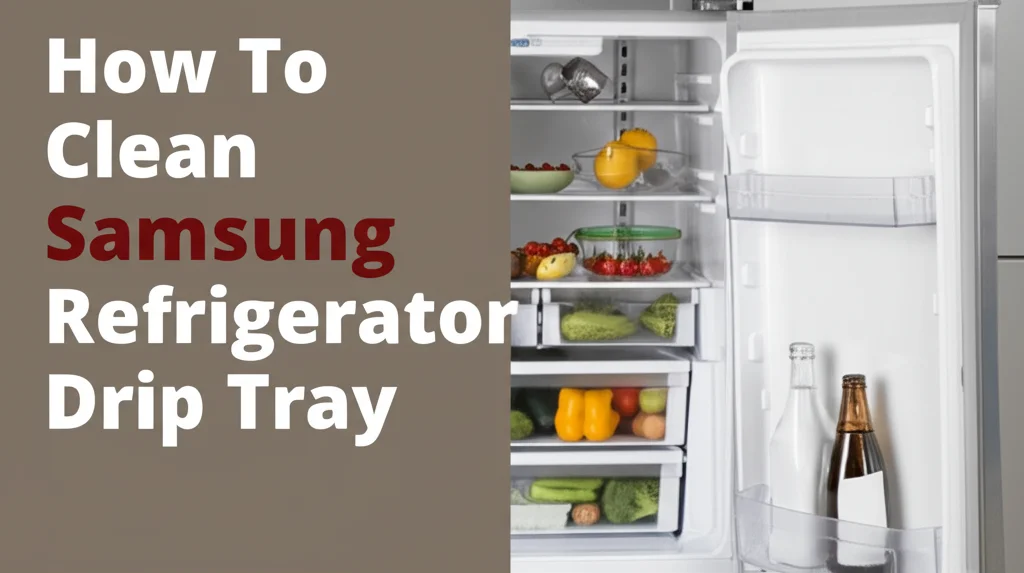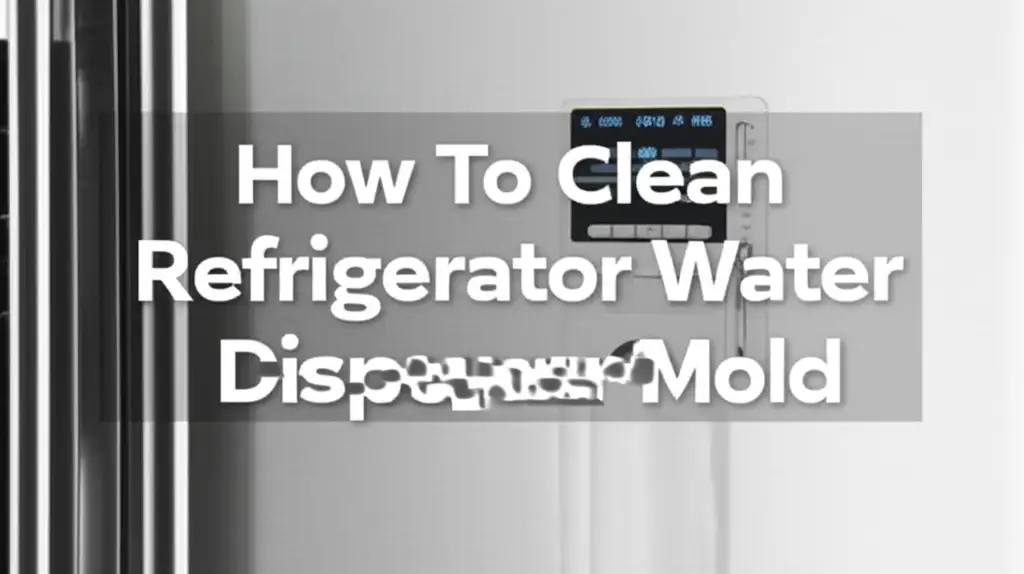· Appliance Cleaning · 7 min read
How To Clean Samsung Refrigerator Drip Tray

Keeping Your Fridge Fresh: How To Clean a Samsung Refrigerator Drip Tray
Is your Samsung refrigerator starting to smell a little funky? A hidden culprit could be the drip tray. This small component collects condensation, and if left uncleaned, it can become a breeding ground for mold and bacteria, leading to unpleasant odors and potentially affecting your food’s freshness. Cleaning your Samsung refrigerator drip tray is a simple task that can make a big difference in maintaining a healthy and odor-free kitchen. This article will guide you through the process, step-by-step, ensuring your fridge stays in top condition. We’ll cover locating the tray, cleaning methods, and preventative measures to keep it fresh.
Takeaway:
- Regularly cleaning your Samsung refrigerator drip tray prevents odors.
- Simple cleaning solutions like warm water and mild detergent are effective.
- Preventative measures, like checking the tray monthly, minimize buildup.
What is a refrigerator drip tray and why should you clean it?
The drip tray, also known as a drain pan, is located underneath your refrigerator. Its job is to catch excess water that results from the defrost cycle. Over time, this water can harbor bacteria and mold, creating unpleasant smells. Cleaning the drip tray is essential for maintaining a hygienic refrigerator and preventing odors from affecting your food.
Locating the Samsung Refrigerator Drip Tray
Finding the drip tray isn’t always straightforward, as its location varies depending on your Samsung refrigerator model. Generally, it’s located at the bottom of the fridge, either behind the kick plate (the panel at the very bottom front) or underneath the refrigerator itself. Let’s break down how to find it:
- Check Behind the Kick Plate: Many Samsung models have a kick plate that can be removed with a screwdriver or by simply snapping it off. Once removed, you should see the drip tray.
- Underneath the Refrigerator: If you don’t find it behind the kick plate, carefully tilt the refrigerator back (ensure it’s unplugged first!) or look underneath it. The tray is usually a shallow pan.
- Consult Your Owner’s Manual: The most reliable way to locate the drip tray is to refer to your Samsung refrigerator’s owner’s manual. It will provide specific instructions for your model. Don’t underestimate the power of a good manual!
Gathering Your Cleaning Supplies
Before you start cleaning, gather the necessary supplies. You won’t need anything fancy – just a few basic items. Having everything ready will make the process quick and efficient. Here’s what you’ll need:
- Warm Water: This is the base for your cleaning solution.
- Mild Dish Soap: A gentle detergent is perfect for removing grime. Avoid harsh chemicals.
- Soft Cloth or Sponge: For wiping down the tray.
- Spray Bottle (Optional): For easier application of the cleaning solution.
- Gloves (Optional): To protect your hands.
- Small Brush (Optional): An old toothbrush can help scrub hard-to-reach areas.
- Baking Soda (Optional): For stubborn odors.
Step-by-Step Guide to Cleaning the Drip Tray
Now that you’ve located the tray and gathered your supplies, let’s get cleaning! Follow these steps for a thorough clean:
- Unplug the Refrigerator: Safety first! Always unplug your refrigerator before performing any maintenance.
- Remove the Drip Tray: Carefully slide or lift the drip tray out of its position. Be prepared for some water spillage.
- Empty the Water: Pour out any accumulated water into a sink or bucket.
- Prepare the Cleaning Solution: Mix warm water with a small amount of mild dish soap in a sink or bucket.
- Wash the Tray: Use a soft cloth or sponge to scrub the inside of the drip tray with the cleaning solution. Pay attention to any areas with visible mold or grime. A small brush can be helpful for tight corners.
- Rinse Thoroughly: Rinse the tray thoroughly with clean water to remove all traces of soap.
- Deodorize (Optional): If there’s a lingering odor, sprinkle a small amount of baking soda into the tray and let it sit for a few minutes before rinsing again.
- Dry Completely: Allow the drip tray to air dry completely before placing it back in the refrigerator.
- Replace the Tray: Carefully slide the clean, dry drip tray back into its position.
- Plug in the Refrigerator: Plug your refrigerator back in.
Dealing with Stubborn Mold and Grime
Sometimes, the drip tray can have stubborn mold or grime that requires a little extra effort. Don’t worry, it’s manageable! Here are a few tips:
- Vinegar Solution: Mix equal parts white vinegar and water for a more powerful cleaning solution. Vinegar is a natural disinfectant and can effectively kill mold.
- Baking Soda Paste: Create a paste of baking soda and water and apply it to stubborn grime. Let it sit for 15-20 minutes before scrubbing.
- Bleach Solution (Use with Caution): As a last resort, you can use a diluted bleach solution (1 tablespoon bleach per gallon of water). However, use this with extreme caution, wear gloves and eye protection, and ensure the tray is thoroughly rinsed afterward. Avoid mixing bleach with other cleaning products.
- Soaking: For heavily soiled trays, consider soaking it in the cleaning solution for 30 minutes before scrubbing.
Preventing Future Buildup and Odors
Cleaning the drip tray is important, but preventing buildup is even better! Here are some tips to keep your Samsung refrigerator drip tray clean and fresh:
- Monthly Checks: Check the drip tray at least once a month. Even if it doesn’t look dirty, emptying any accumulated water can prevent problems.
- Proper Ventilation: Ensure your refrigerator has adequate ventilation around it. This helps reduce condensation.
- Avoid Overfilling: Don’t overfill your refrigerator, as this can increase condensation.
- Regular Refrigerator Cleaning: Regularly clean the inside of your refrigerator to prevent food spills and odors that can contribute to drip tray buildup. You might find cleaning your refrigerator interior as easy as learning how to clean vinyl plank flooring.
- Consider a Drip Tray Liner: Some people use disposable drip tray liners to make cleanup even easier.
FAQ: Common Questions About Samsung Refrigerator Drip Trays
Q: How often should I clean my Samsung refrigerator drip tray?
A: Ideally, you should check and clean your drip tray monthly. However, if you notice any unpleasant odors, clean it immediately. Regular maintenance prevents buildup and keeps your fridge smelling fresh.
Q: Can I use harsh chemicals to clean the drip tray?
A: It’s best to avoid harsh chemicals like bleach (unless heavily diluted and used with caution) and abrasive cleaners. These can damage the tray and potentially contaminate your refrigerator. Mild dish soap and warm water are usually sufficient.
Q: My drip tray is difficult to remove. What should I do?
A: Consult your Samsung refrigerator’s owner’s manual for specific instructions on removing the drip tray. If it’s still stuck, gently try wiggling it back and forth while pulling upwards. Avoid using excessive force.
Q: What causes the drip tray to fill up with water?
A: The drip tray fills up with water due to the defrost cycle. During this cycle, frost that accumulates on the evaporator coils melts and drains into the tray. This is a normal process, but regular cleaning is necessary to prevent issues.
Conclusion: A Fresh Fridge is a Happy Fridge
Cleaning your Samsung refrigerator drip tray is a simple yet crucial part of refrigerator maintenance. By following the steps outlined in this guide, you can eliminate unpleasant odors, prevent mold growth, and ensure your fridge operates efficiently. Remember to check the tray monthly and address any buildup promptly. A clean drip tray contributes to a healthier, fresher kitchen environment. Don’t let a small detail like a dirty drip tray compromise the quality of your food or the cleanliness of your home. Take a few minutes each month to give your Samsung refrigerator the care it deserves, and you’ll enjoy a fresh, odor-free fridge for years to come. If you’re looking for more ways to keep your home sparkling, consider exploring tips on how to remove baking soda residue from tile.
- Samsung Refrigerator
- Refrigerator Maintenance
- Drip Tray Cleaning




